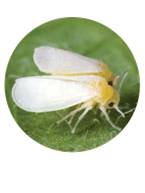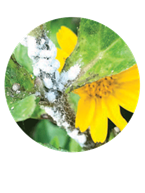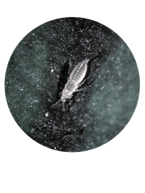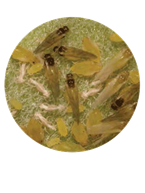The Problem
Scale insects are all members of a diverse group of piercing-sucking pests (Hemiptera) and can be common in greenhouses, nursery production, and landscapes. These insects are notorious for attacking all types of ornamental plants, and when not controlled, can move across the country on plant material. Scale insects are small (<1/8”) insects that use hair-like mouthparts to extract sap from leaves and branches. These insects can secrete a waxy covering protecting them from adverse environmental conditions as well as insecticide applications, which makes control a challenge. Scale insects that attack ornamental plants can generally be divided into either armored or soft scales.
What To Look
For Most growers admit that scales are easily overlooked, primarily because they remain immobile for most of their lives. Armored scales form a protective cover over their bodies varying in size, shape and color. This protective cover can be removed to reveal a soft-bodied insect feeding beneath. Most species contain eggs beneath the protective cover that hatch releasing tiny (<1/32”) mobile crawlers that move to new feeding sites. The crawlers begin to feed by piercing plant tissue with their mouth parts and soon they secrete a protective cover, lose their legs becoming sedentary, and the life cycle begins again. Some of the more common armored scales include florida red scale, false oleander scale, tea scale, cycad scale, boisduval scale, japanese scale, juniper scale, obscure scale, gloomy scale, euonymus scale, san jose scale, oystershell scale, pine needle scale and white peach scale.
Soft scales are typically larger and appear dome shaped. Most are covered with a waxy substance, but all soft scales lack the protective cover characteristic of armored scales. Fertilized females will feed and eventually lay eggs that hatch into tiny crawlers. The crawlers will find a suitable feeding site, but unlike armored scales, female soft scales are mobile in every life stage until they begin to produce eggs. Some of the more common soft scales include magnolia scale, fletcher scale, calico scale, tuliptree scale, croton scale, lecanium scales, hemispherical scale, brown soft scale, tortoise scale, striped pine scale, cottony scales, wax scales, oak kermes scale and european elm scale.
There may be no symptoms when just a few individuals are present, but larger populations of scale insects can cause stunting and chlorosis. The upper surface of leaves may appear shiny and develop yellow spots from scales feeding underneath, branches often die back, and sometimes plants completely defoliate. Black sooty mold, which is indicative that scale is feeding, may be present on branches, leaves and stems.
The Solution
Scale insects are excellent opportunists and are more likely to become an issue on stressed plants. This is especially true when plants are relocated via shipping or transplanted into a landscape. It is inevitable that these plants will endure some stress and if any scale insects are already present on the host plants or in the new location, the population will likely flourish on the weakened host. This emphasizes the importance of early and routine scouting of plants for scales. Scales are most active in early spring and continue through summer except for more tropical areas where crawlers can be found all year long.
Highly susceptible plants should be monitored closely. When it comes to effective control, early detection followed by isolation of infested plants is crucial. Evidence of scales requires immediate treatment with an effective insecticide to minimize further damage and eliminate the potential for spread to healthy plants. For optimum control, insecticides should be applied preventatively or when crawlers are active. Timing of application is especially important for contact insecticides. It is always important to positively identify all insect pests including scales, especially when using biological controls, as there are some scale parasitoids that are species specific.
Additional resources
| Solution sheet - Scale insects |







